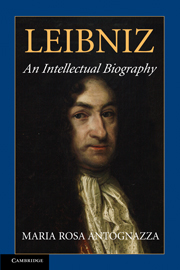Book contents
- Frontmatter
- Dedication
- Contents
- Acknowledgements
- Abbreviations
- Chronological Table
- Introduction
- PART I YOUTHFUL VOCATIONS (1646–1676)
- PART II DREAMS AND REALITY (1676–1716)
- 4 A Universal Genius as Librarian, Historian, and Mining Engineer: Hanover and Lower Saxony (December 1676–October 1687)
- 5 In the Footsteps of the Guelfs: Southern Germany, Austria, and Italy (November 1687–June 1690)
- 6 Back under the Guelf Dukes: Hanover and Wolfenbüttel (June 1690–February 1698)
- 7 Between Brother and Sister: Hanover and Berlin (February 1698–February 1705)
- 8 Light and Shadows: Hanover, Berlin, Wolfenbüttel, Vienna (February 1705–September 1714)
- 9 Epilogue: Last Years in Hanover (September 1714–November 1716)
- Appendix
- References
- Index
5 - In the Footsteps of the Guelfs: Southern Germany, Austria, and Italy (November 1687–June 1690)
Published online by Cambridge University Press: 05 September 2014
- Frontmatter
- Dedication
- Contents
- Acknowledgements
- Abbreviations
- Chronological Table
- Introduction
- PART I YOUTHFUL VOCATIONS (1646–1676)
- PART II DREAMS AND REALITY (1676–1716)
- 4 A Universal Genius as Librarian, Historian, and Mining Engineer: Hanover and Lower Saxony (December 1676–October 1687)
- 5 In the Footsteps of the Guelfs: Southern Germany, Austria, and Italy (November 1687–June 1690)
- 6 Back under the Guelf Dukes: Hanover and Wolfenbüttel (June 1690–February 1698)
- 7 Between Brother and Sister: Hanover and Berlin (February 1698–February 1705)
- 8 Light and Shadows: Hanover, Berlin, Wolfenbüttel, Vienna (February 1705–September 1714)
- 9 Epilogue: Last Years in Hanover (September 1714–November 1716)
- Appendix
- References
- Index
Summary
The research trip in the footsteps of the Guelfs was supposed to take no more than a few months and to be limited to southern Germany. In the event, it stretched over almost two years and eight months and took Leibniz as far south as Naples. Its original official aim was to visit some archival collections in southern Germany, notably in Munich, in order to verify the origins of a northern Italian margrave, Albert Azzo II (996–1097). Azzo II was regarded as the common ancestor of both the Braunschweig-Lüneburg house and the prestigious Italian family of Este, which ruled Modena and Reggio with their surrounding territories in north-central Italy. Doubts about this connection, however, had been raised by French and German historians: in particular, the famous historian Johannes Turmair, known as Aventin, in his printed Latin Annals of Bavaria had mentioned Azzo II as Astenses rather than Estenses. This designation traced back the origins of Azzo to the marquises of Asti, a town in the northern Italian region of Piemonte, rather than the far more prestigious house of Este. Since Aventin's original manuscripts were held in Munich, Leibniz decided to check them directly in the hope of tracing the historian's sources and finding further evidence which would decide the vexed question.
- Type
- Chapter
- Information
- LeibnizAn Intellectual Biography, pp. 281 - 319Publisher: Cambridge University PressPrint publication year: 2008

